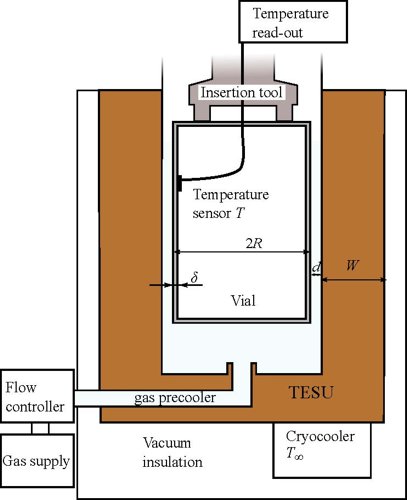For rapid freezing of a biopsy taken from a patient, for cancer research for example, the standard procedure is using liquid nitrogen. This, however, is not allowed inside the operating room. The consequence is a laborious procedure causing unnecessary delay. Researchers of the University of Twente developed a ‘snap freezing’ apparatus that cools a vial even faster than in liquid nitrogen, and is safe for use inside the operating room. Another advantage is that the speed of cooling is adjustable. The new device is presented in Nature’s ‘Scientific Reports’. The Dutch VUmc hospital is already running experiments using the new device.
For finding personalized cancer treatments, for example, molecular medicine is an emerging field. For many laboratory tests, a biopsy is kept at room temperature all the way from taking the tissue sample to the lab. But for protein analysis, proteomics, the tissue has to be frozen instantly. This is also called snap freezing and is made possible by immersing a vial containing the tissue in a bath of liquid nitrogen, cooling it down to minus 196 degrees Celsius. To avoid risks for the patient and medical staff, this cannot be done inside the operation theatre. In practice someone is ready, waiting directly outside with a liquid nitrogen container, wearing protecting clothing. There is still delay in moving the sample outside, this procedure may influence the lab results. The new snap freezer developed by UT scientist, can simply be connected to the mains and does not have any risk of physical contact or breathing harmful cooling gas or liquid. Special gloves or clothing aren’t necessary either. The apparatus freezes vials even faster than in liquid nitrogen - down to minus 173 degrees Celsius within 10 seconds -, and it is more flexible as the cooling speed can be adjusted.
Not too large
Although so-called cryocoolers are available on the market, the challenge is keeping it compact. A hospital simply is not helped by a cooler of a cubic meter in size, costing a lot of money: this would be needed to get the necessary cooling capacity. Thanks to a smart design, this can be reduced substantially.

Schematic overview of the new freezing apparatus, with the tissue insertion point, heat buffer, cryocooler and gas supply.
The solution now found, consists of a very compact cryocooler, a buffer made of copper for retaining the low temperature (thermal energy storage unit, TESU) and a closed helium gas system that works as a heat exchanger. There is a gap between the TESU and the vial with the biopsy for contact gas flow. Next to the direct cooling effect, the researchers expected to see cooling by the movement of the gas – compare it to the windchill making us feel colder than the actual temperature. Surprisingly, this effect cannot be demonstrated in this case. Apart from developing a new device, the research also gives new physical insights in gas flows.
The medical center of the Free University in Amsterdam (VUmc) is testing the device, at this moment in a policlinic setting because for actual use in the operation theatre, certification is still necessary. The team lead by Srinivas Vanapalli is also working on a sustainable solution for cold transport, for example when a tissue sample has to be moved over a large distance to another lab. Except for diagnostics, rapid cooling devices are also promising in treatment, killing tumor cells in a highly targeted way. This is currently another field of research addressed together with cryoablation specialists.
The research was done in the Energy, Materials and Systems group of Prof Marcel ter Brake. This group has a lot of experience with superconductivity, for example for CERN and ITER, and the very low temperatures needed for that. Developing coolers for a wide range of applications has become a research field of its own in this group.
The project was made possible by the NWO-TTW, the applied and technical sciences section of the Netherlands Organisation for Scientific Research. The project is called CryoON-Cryogenics meets Oncology.
The paper ‘Cooling of a vial in a snapfreezing device without using sacrificial cryogens’, by Michiel van Limbeek, Sahil Jagga, Harry Holland, Koen Ledeboer, Marcel ter Brake en Srinivas Vanapalli, appears in Nature's Scientific Reports.





